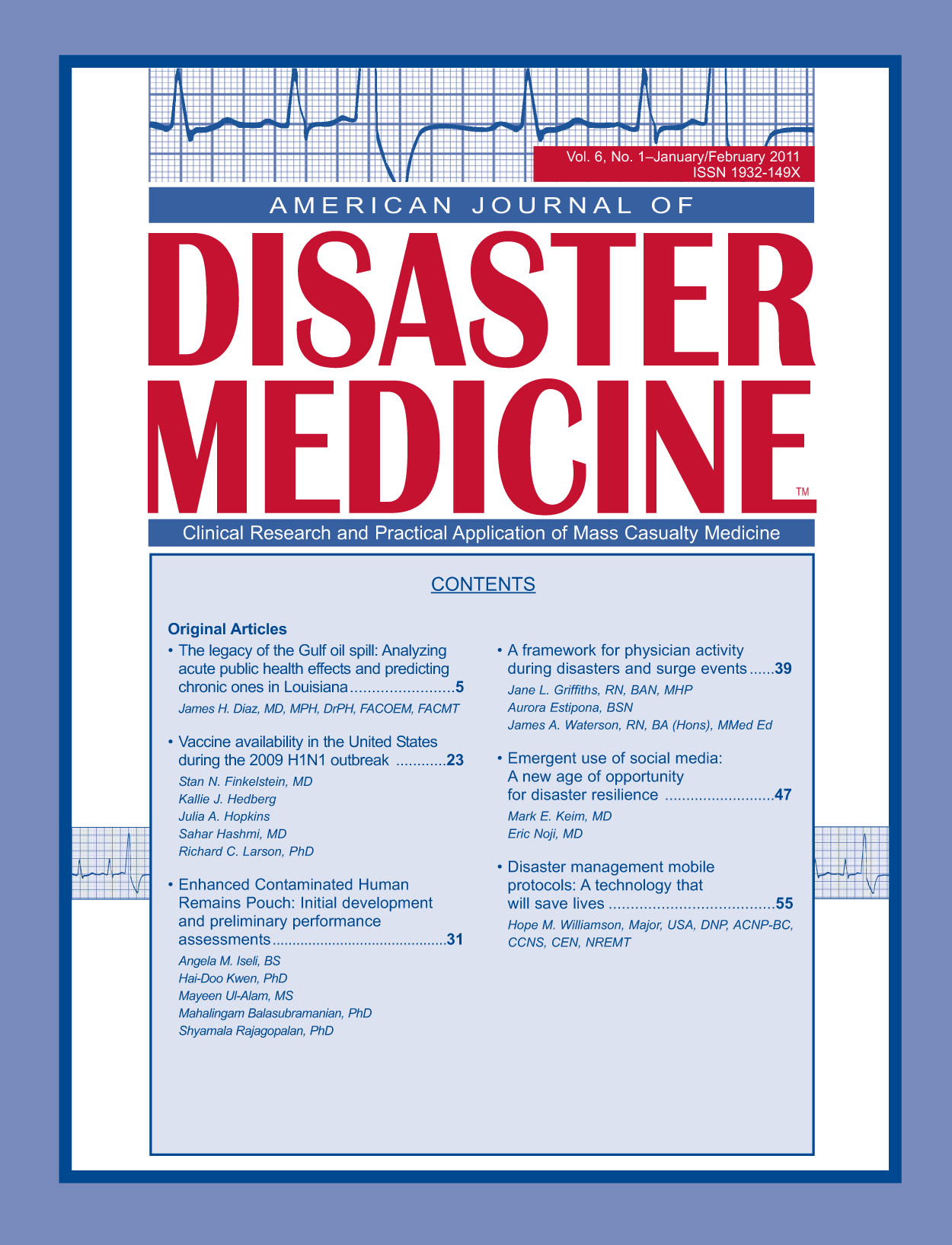Disaster management mobile protocols: A technology that will save lives
DOI:
https://doi.org/10.5055/ajdm.2011.0045Keywords:
chemical, biological, radiological, nuclear, and high-yield explosives, weapons of mass destruction, mass casualty incident, disaster management mobile protocolsAbstract
Although training and education have long been accepted as integral to disaster preparedness, many currently taught practices are neither evidence based nor standardized.The need for effective evidence-based disaster education for healthcare workers at all levels in the multidisciplinary medical response to major events has been designated by the disaster response community as a high priority. This article describes a disaster management mobile application of systematic evidence-based practice. The application is interactive and comprises portable principles, algorithms, and emergency protocols that are agile, concise, comprehensive, and response relevant to all healthcare workers. Early recognition through clinical assessment versus laboratory and diagnostic procedures in chemical, biological, radiological, and nuclear (CBRNE) exposures grounded in an evidencebased skill set is especially important. During the immediate threat, the clinical diagnosis can get frustrating because CBRNE casualties can mimic everyday healthcare illnesses and initially present with nonspecific respiratory or flu-like symptoms. As there is minimal time in a catastrophic event for the medical provider to make accurate decisions, access to accurate, timely, and comprehensive information in these situations is critical. The CBRNE mobile application is intended to provide a credible source for treatment and management of numerous patients in an often intimidating environment with scarce resources and overwhelming tasks.References
Wallace R: Borden Institute releases medical aspects of biological warfare. Available at http://www.bordeninstitute.army.mil/published_volumes/biological_warfare/FINALRELEASEdembekmljrmm12-21Biobook.pdf. Accessed May 15, 2010.
Phillips SJ, Knebel A (eds.): Mass Medical Care with Scarce Resources: A Community Planning Guide. Rockville, MD:Agency for Healthcare Research and Quality, 2007.
Swain C: WISER and REMM: Resources for disaster response. J Electron Resour Med Libr. 2009; 6(3): 253-259.
Merholz P: Don’t design for mobile, design for mobility. Available at http://www.adaptivepath.com/blog/2008/01/02/dont-design-formobile-design-for-mobility/. Accessed April 5, 2010.
Hsu B, Thomas T, Bass E, et al.: Healthcare worker competencies for disaster training. BMC Med Educ. 2006; 6(19): 1-9.
Tonev S, Kanev K, Dishovsky C: Medical management of chemical and biological casualties. J Med Chem Biol Radiol Def. 2010; 8: 26-38.
Smith E, Wasiak J, Sen A, et al.: Three decades of disasters: A review of disaster-specific literature from 1977-2009. Prehosp Disaster Med. 2009; 24(4): 306-311.
Gordon Center for Research in Medical Education: University of Miami Emergency Response to Terrorism Provider Manual. 3rd ed. Miami, FL: Gordon Center for Research in Medical Education, 2007.
Chan T, Killeen J, Griswold W, et al.: Information technology and emergency medical care during disasters. Acad Emerg Med [serial online]. 2004; 11(11): 1229-1236.
Poropatich RK, DeTreville R, Lappan C, et al.: The U.S. Army telemedicine program: General overview and current status in Southwest Asia. Telemed J E Health. 2006; 12(4): 396-408.
Obama B: White House speech presented at Prague.Available at http://www.whitehouse.gov/the_press_office/Remarks-By-President-Barack-Obama-In-Prague-As-Delivered/. Accessed April 15, 2010.
Gum RM, Hoyle JD: CBRNE—Chemical warfare mass casualty management. Available at http://emedicine.medscape.com/article/831375-overview. Accessed April 24, 2010.
Ciraulo DL, Frykberg ER, Feliciano DV, et al.: A survey assessment of the level of preparedness for domestic terrorism and mass casualty incidents among eastern association for the surgery of trauma members. J Trauma. 2004; 56(5): 1033-1041.
Trunkey D: US trauma center preparation for a terrorist attack in the community. Eur J Trauma Emerg Surg [serial online]. 2009; 35(3): 244-264.
Subbarao I, Bond W, Johnson C, et al.: Using innovative simulation modalities for civilian-based, chemical, biological, radiological, nuclear, and explosive training in the acute management of terrorist victims: A pilot study. Prehosp Disaster Med. 2006; 21(4): 272-275.
McAlearney S, Schweikhart S, Medow M: Doctor’s experience with handheld computers in clinical practice: Qualitative study. BMJ. 2004; 328(1): 1-5.
The National Academies and the US Department of Homeland Security: Fact sheets on chemical, biological, radiological and nuclear attacks. The National Academies and the US Department of Homeland Security,Washington, DC. Available at http://www.nae.edu/nae/pubundcom.nsf/weblinks/CGOZ-642P3W?OpenDocument. Accessed April 10, 2010.
U.S. Army Medical Research Institute: Medical Management of Chemical Casualties Handbook. Aberdeen Proving Ground, MD: U.S. Army Medical Research Institute, 2007.
U.S. Army Medical Research Institute of Infectious Diseases: Medical Management of Biological Casualties Handbook. Frederick, MD: U.S. Army Medical Research Institute of Infectious Diseases, 2005.
American Association of Colleges of Nursing: The Essentials of Doctoral Education for Advanced Nursing Practice. Washington, DC: American Association of Colleges of Nursing, 2006.
Published
How to Cite
Issue
Section
License
Copyright 2007-2023, Weston Medical Publishing, LLC
All Rights Reserved


